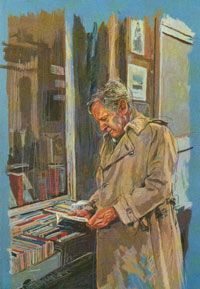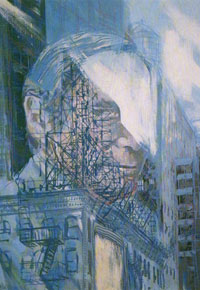Dirk Görtler
remembers William Gaddis
in Germany
William Gaddis outside a secondhand
bookstore in Freiburg,
Germany, by Dirk Görtler.
Gouache/tempera on cardboard, 40x55cm, 1988.

Freiburg was the last stop on Gaddis's 1987 German reading tour, organized by the cultural department of the American embassy in Bonn. Although his stay was short, he wanted to see the Freiburg area, and was reported to have been especially impressed by the Issenheimer Altar in the Unterlinden Museum in Colmar/Alsace 30 miles west of Freiburg across the French border. His work hadn't yet appeared in German translation, so he was largely unknown to German readers: his grand entrance onto the German stage came in 1997 after The Recognitions, J R , and A Frolic of His Own had been translated. In Freiburg Gaddis stayed in the Markgräfler Hof, Gerberau No. 22, a few minutes' walk from the Alte Universität where the reading took place. The first photographs Dirk Görtler took didn't come out well, he says, as lighting was very poor, so he took additional photos of Gaddis in front of the hotel the next day. The one taken outside a small secondhand bookstore across from the Markgräfler Hof became the basis for one of two paintings Dirk Görtler did of William Gaddis in 1988 (picture 1). -- Anja Zeidler
At that time I always took photos when meeting American writers and artists. Some I met in Freiburg, others in New York or San Francisco: Bob Creeley, Raymond Federman, Ishmael Reed, N. Scott Momaday, Simon Ortiz, Gerald Vizenor, Maxine Hong Kingston, Ron Sukenick, William H. Gass, Anne Waldman, William Burroughs, Alan Ginsburg, Lynne Tillman, Kathy Acker, Jayne Ann Phillips, Kurt Vonnegut, Frank O'Hara, Ken Kesey, Richard Brautigam, Paul Bowles, Hubert Selby Jr., Paul Auster, Gerard Malanga, Kiki Smith, Mark Amerika, Ed Sanders, Richard Hell, Henry Rollins, and many more. Some of my photos were used by Rowohlt, Fischer, and other publishers.
I found that the secondhand bookstore in front of the hotel was a good environment for Gaddis. The bookstore no longer exists. It belonged to a lovely elderly couple, who lived in their bookstore, more or less. It smelled of food when they had warmed up something in the back room. The shop was a chaotic mix of worthless stuff and a few treasures: in one of my photos one can see the white-haired store owner, the surprised look on his face meant for the photographer. Next to Gaddis's hand in the picture is a book with the name Joyce on it. It's not a book by James Joyce, of course, but one by Joyce Carol Oates. Gaddis was wearing that threadbare raincoat. Freiburg was his last stop on the reading tour through Germany and his coat had the marks of a long journey . When I accompanied him to the station the next day, I was concerned when I recognized a slight attack of travel panic.
The reading took place at the small cafeteria of the old university. I remember that it was cold and there was a draft the whole time. It was not a good place for a reading, totally unsuited actually, but it seems the organizers hadn't been able to find anything better for that day. There were only about 30 people at the reading, but few people in Germany knew Gaddis at that time. There was great surprise among the audience when they recognized who was in front of them. Gaddis didn't read from any of his novels, he would never do that . Instead he had a pile of index cards with him and read from notes he had made on them. He talked about his work, about his own estimation of the readers of his books. He made fun of those people who suggested that they had read his novels from cover to cover, but were only able to quote from the first 50 pages or so. He believed that there was almost no one who had actually read The Recognitions or J R to the very end. He also talked about the sources he had used in his writing, but unfortunately I didn't take notes. Gaddis was quite nervous and fidgety, and didn't seem to feel comfortable in his role at all. He constantly rearranged his cards. I had the impression that that was because at that point he had come to feel his own notes were boring, and in reading them to his small audience, was wondering if people were really interested. When I talked to him during dinner later, we mainly talked about art, about Julian Schnabel above all, a friend of his for whom he had written a piece for a catalogue. But generally, Gaddis said, he wasn't an expert in contemporary art and was almost apologetic about it.
Gaddis told me that in a classic novel the first page describes the room, the next page describes a person in that room, and the next describes another person entering the room. Only after all that description does the action start. He thought that was boring. And boredom was something that increased with age (I still can't confirm that). So he decided to omit anything superfluous and write dialogue novels. There is no more concise way, I think, to describe what Gaddis did. The painting in front of the secondhand bookstore is a more personal one compared to the second portrait, which shows only half of Gaddis's face behind the scaffold of a billboard on Broadway. The scaffold and the faded-out face were meant as a metaphor for Gaddis's style.
When a few years later William Gaddis's novels had been translated into German and he was a great success here, Gaddis read at the Frankfurt Book Fair, with his translator. I was invited and couldn't believe he would really read from his novels. But maybe people had talked him into it, I thought. When I arrived the organizer apologized a thousand times, because after all Gaddis hadn't come. So, he had remained faithful to himself. The translator and an actor had to go through the reading on their own.
